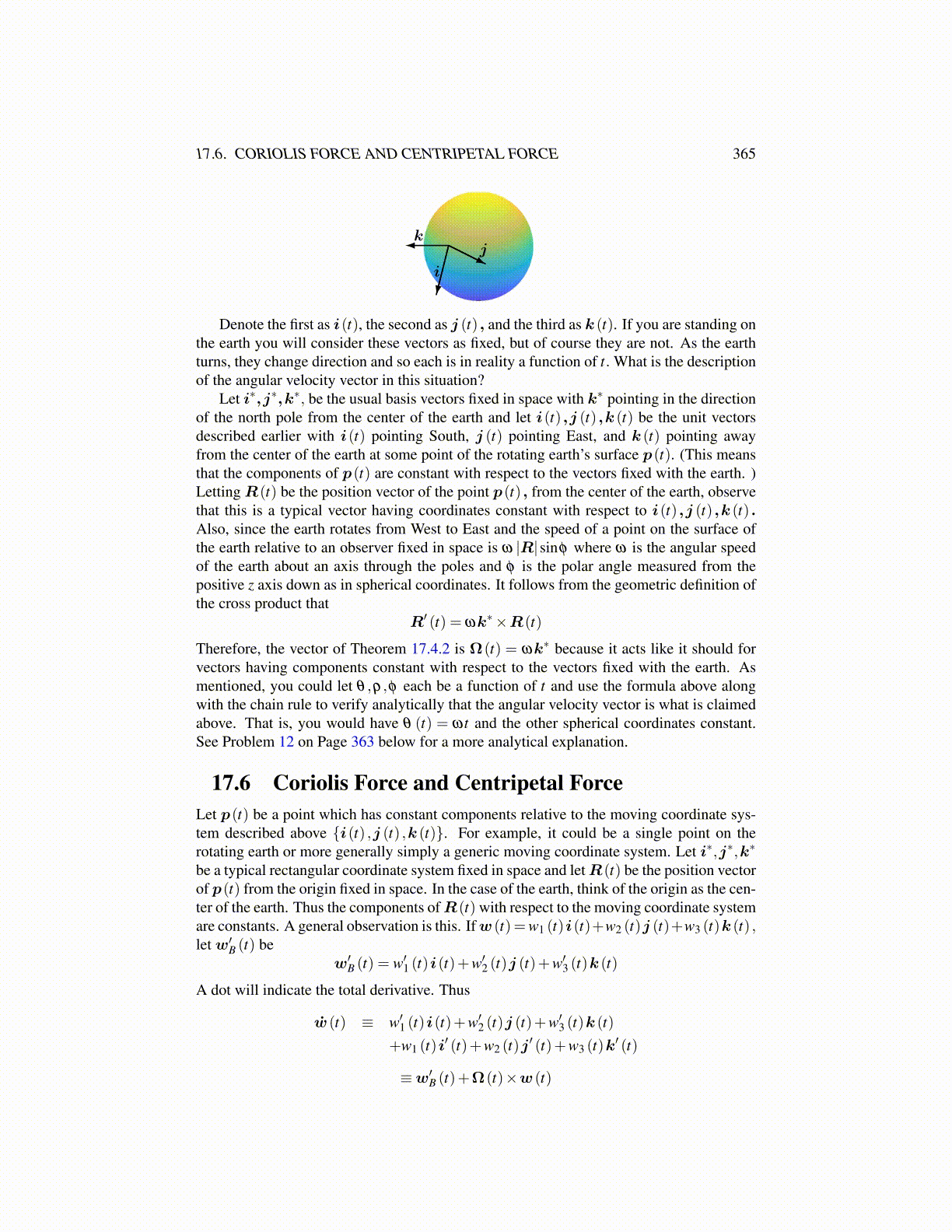
17.7. CORIOLIS FORCE ON THE ROTATING EARTH 365
If the acceleration a is due to gravity, then
aB = a−Ω× (Ω×R)−2Ω×vB =
≡g︷ ︸︸ ︷−GM (R+rB)
|R+rB|3−Ω× (Ω×R)−2Ω×vB ≡ g−2Ω×vB.
Note thatΩ× (Ω×R) = (Ω·R)Ω−|Ω|2R
and so g, the acceleration relative to the moving coordinate system on the earth is notdirected exactly toward the center of the earth except at the equator or at poles, althoughthe components of acceleration which are in other directions are very small when comparedwith the acceleration due to the force of gravity and are often neglected. Therefore, ifthe only force acting on an object is due to gravity, the following formula describes theacceleration relative to a coordinate system moving with the earth’s surface.
aB = g−2(Ω×vB)
While the vector Ω is quite small, if the relative velocity vB is large, the Coriolis accelera-tion could be significant. This is described in terms of the vectors i(t) ,j (t) ,k (t) next.
Letting (ρ,θ ,φ) be the usual spherical coordinates of the point p(t) on the surfacetaken with respect to i∗,j∗,k∗ the usual way with φ the polar angle, it follows the i∗,j∗,k∗
coordinates of this point are ρ sin(φ)cos(θ)ρ sin(φ)sin(θ)
ρ cos(φ)
.
It follows,i= cos(φ)cos(θ)i∗+ cos(φ)sin(θ)j∗− sin(φ)k∗
j =−sin(θ)i∗+ cos(θ)j∗+0k∗
andk= sin(φ)cos(θ)i∗+ sin(φ)sin(θ)j∗+ cos(φ)k∗.
It is necessary to obtain k∗ in terms of the vectors, i(t) ,j (t) ,k (t) because, as shownearlier, ωk∗ is the angular velocity vector Ω. To simplify notation, I will suppress thedependence of these vectors on t. Thus the following equation needs to be solved for a,b,cto find k∗ = a i+bj+ ck
k∗︷ ︸︸ ︷ 001
= a
i︷ ︸︸ ︷ cos(φ)cos(θ)cos(φ)sin(θ)
−sin(φ)
+b
j︷ ︸︸ ︷ −sin(θ)cos(θ)
0
+ c
k︷ ︸︸ ︷ sin(φ)cos(θ)sin(φ)sin(θ)
cos(φ)
(17.18)
The solution is a =−sin(φ) ,b = 0, and c = cos(φ) .Now the Coriolis acceleration on the earth equals
2(Ω×vB) = 2ω
k∗︷ ︸︸ ︷−sin(φ) i+0j+ cos(φ)k
×(x′ i+ y′ j+ z′k
).